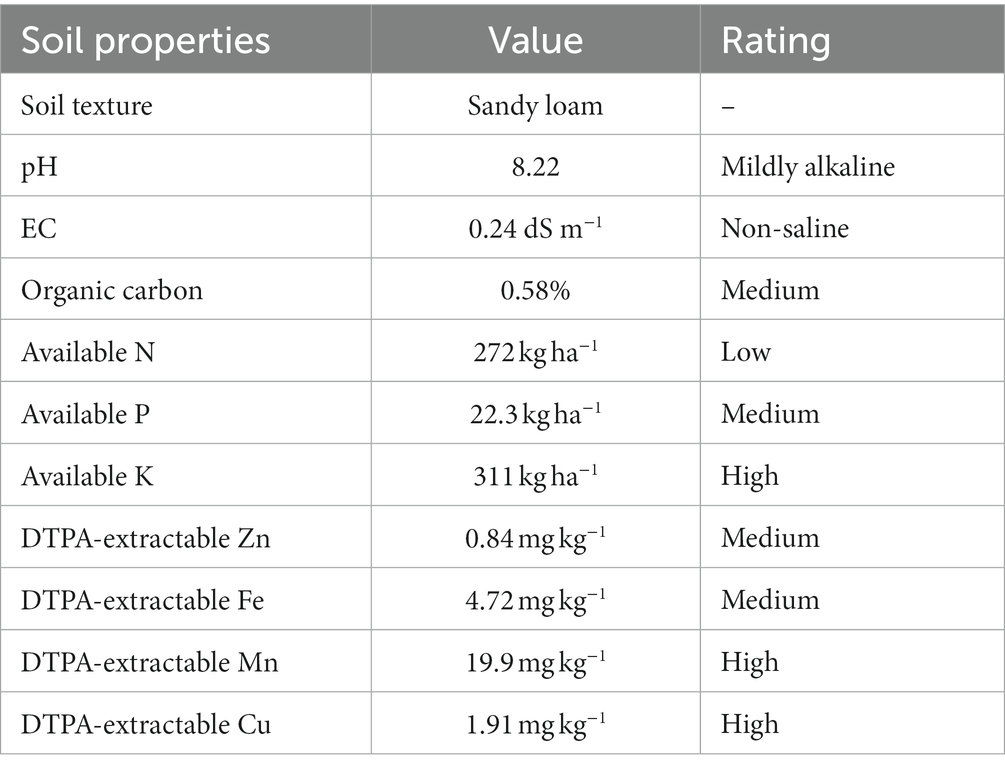- 1ICAR-Indian Agricultural Research Institute, New Delhi, India
- 2ICAR-Central Research Institute for Dryland Agriculture, Hyderabad, India
- 3ICAR- Directorate of Groundnut Research, Regional Station, Ananthapur, India
- 4Agricultural Scientist Recruitment Board, New Delhi, India
- 5Indian Farmers Fertiliser Cooperative Limited, New Delhi, India
- 6GD Goenka University, Sohna, India
- 7ICAR Research Complex for NEH Region, Sikkim Centre, Gangtok, India
- 8ICAR- Indian Agricultural Statistics Research Institute, New Delhi, India
It is widely accepted that deficiency of macro (nitrogen) and micronutrients (zinc, copper etc.) affects the plant growth and development which cause a significant threat to crop production and food security. The Indian Farmers Fertilizer Cooperative (IFFCO) developed nano-urea (nano-N), nano-zinc (nano-Zn), and nano-copper (nano-Cu) liquid fertilizer formulations to enhance the crop yields, simultaneously addressing the nutrient deficiency, without causing toxicity. Therefore, this study was formulated to evaluate the effectiveness of nano-N (nano-urea), nano-Zn, and nano-Cu at varying N levels [0, 50, 75, and 100% of the recommended rates of nitrogen (RRN)] on maize-wheat and pearl millet-mustard systems during 2019–20 and 2020–21. The results exhibited that the application of nano-N + nano-Zn with 100% RRN exhibited significantly higher grain yields in maize (66.2–68.8%), wheat (62.6–61.9%), pearl millet (57.1–65.4%), and mustard (47.2–69.0%), respectively, over absolute control plots and combinations of three nano-fertilizers like nano-N + nano-Zn + nano-Cu applied plots. This was mainly attributed to the higher N and Zn uptake by the crops. However, 75% RRN with nano-N + nano-Zn also produced comparable yields. Thus, applying nano-N and nano-Zn via foliar applications, in conjunction with conventional urea, has the potential to reduce the required nitrogen fertilizer amount by up to 25%, while simultaneously maintaining equivalent yield levels. Similarly, 100% RRN and 75% RRN + nano-N + nano-Zn registered comparable profitability, soil mineral N, dehydrogenase activity (DHA), and soil microbial biomass carbon (SMBC), during both the study years. However, further research and field trials on nano fertilizers alone or in combination with conventional fertilizers are essential to fully unlock its benefits and ascertain its long-term effects which may offer a pathway to more efficient and eco-friendly crop nourishment.
1. Introduction
Macro and micronutrient deficiency in crop and soil have risen significantly over the past few years in India as well as globally (Shukla et al., 2021). The major reason behind the upsurge these deficiencies are growing of high-yielding crop varieties (Shukla et al., 2018), increased cropping intensity (Behera et al., 2021), and decreased or no usage of organic manures (Shukla et al., 2021). With the increasing demand of food for growing population, a disproportionate reliance on the excessive use of chemical fertilizers, specifically nitrogen (N) (Wen et al., 2017; Upadhyay et al., 2022) in agricultural practices has been evident in the recent past. Due to the injudicious use of conventional chemical fertilizers, the environment is polluted in terms of deteriorating soil quality (Oenema et al., 2014; Krasilnikov et al., 2022), eutrophication (Liu et al., 2021), groundwater pollution (Norton et al., 2015; Ye et al., 2020), and air pollution (Kumar et al., 2021) as well as diminished soil macro and micronutrient-supplying capacity (Babu et al., 2022). The most deficient among the micronutrients in Indian conditions is Zn (Shukla and Behera, 2020). The lack of micronutrients in the soil reduces grain nutritional quality in addition to crop yield (Fageria et al., 2002; Phattarakul et al., 2012; Dapkekar et al., 2018; Shukla et al., 2021). Micronutrient insufficiency occurs when animals and humans consume food (obtained from crops) with low micronutrient concentrations (Shukla et al., 2021). Insufficient dietary intake of zinc (Zn), which poses a significant health issue (Kihara et al., 2020), remains a pressing concern, especially in the underdeveloped countries, affecting both crop production and human nutrition (Manzeke et al., 2019). However, the foliar application of novel nano fertilizers (macro and micronutrients) in crops can reduce the nutrient deficiency in plants and animals.
Improved crop yields and grain quality can be achieved by the use of nano-fertilizers (Hu and Xianyu, 2021) which are built on nano-scale (1–100 nm) substrates (Peters et al., 2014; Babu et al., 2022). Many people believe that the use of these novel nano-fertilizers (Bartolucci et al., 2022) could lead to a shift in the agricultural practices (Verma et al., 2022). The adoption of nano-fertilizer (Jha et al., 2023) could be a big step toward the objective of sustainable agriculture (Mahapatra et al., 2022) in India and around the world, through curtailing of fertilizer dosages (Kumar et al., 2021; Upadhyay et al., 2023) and reducing runoff, leaching, and emission of gas in the atmosphere (Manjunatha et al., 2016). Indian Farmers Fertiliser Cooperative (IFFCO) has developed and patented three nano-fertilizer formulations viz. nano-urea/nano-N (Indian patent application number 201921044499), nano-Zn (Indian patent application number 201921044497) and nano-Cu (Indian patent application number 201921044498). Many researchers have found that spraying crops with nano-urea improves the crop yield under the field conditions (Das et al., 2016; Manikandan and Subramanian, 2016; Raliya et al., 2017; Du et al., 2019; Rathore et al., 2019; Kumar et al., 2021; Upadhyay et al., 2023).
Concurrently, nanoparticles, such as urea hydroxyapatite nanohybrid (Kottegoda et al., 2017), nano potassium (Al-Juthery et al., 2019), Zn nanoparticles (Drostkar et al., 2016), nano zinc oxide (ZnO) (Du et al., 2019), nano-micronutrients (Fe, Mn, Zn, Cu, Mo, and B) (Kanjana, 2020), silver nano particles (Mosa et al., 2021), nano copper oxide (CuO) (Dimkpa et al., 2019) etc. have been found to increase the plant growth in agricultural crops (Ahmed et al., 2021). However, most of this research has only been conducted in the lab or in pots. Although nanoparticles have been shown to be highly toxic to many plant species (Chen et al., 2015; Khan et al., 2019), they also play an important role in reducing heavy metal stress (Noman et al., 2020; Zhou et al., 2020) and promoting plant development (Salam et al., 2022). Plants can easily absorb excessive amount of Cu2+ and Zn2+ (Dong et al., 2022), leading to a wide range of structural and cellular abnormalities (Rizvi and Khan, 2018). Therefore, non-toxic nano-fertilizers are required to enhance the grain nutrient content as well as the crop yields.
Among micronutrients, zinc (Zn) plays a role in improving photosynthesis (Arough et al., 2016; Cabot et al., 2019), chlorophyll content (Sakya et al., 2018), grain yield (Ibrahim et al., 2017; Mahmood et al., 2019), relative water content (Pavia et al., 2019), the body’s antioxidant defense system (Olechnowicz et al., 2018), and disease resilience etc. Therefore, for efficient utilization of N, Zn, Cu etc. their nano formulation is urgently needed (Ali et al., 2019). Nano fertilizers are gaining significant popularity and recognition as one of the most valuable nanomaterials (Salam et al., 2022) due to their small size, unique shape, and intriguing physicochemical properties (Selim et al., 2020). Increasing crop yield while using less conventional fertilizer on the environment is possible with nano-enabled agriculture (Milani et al., 2012; Sabir et al., 2020). A detailed study exploring the impact of the application of nano fertilizers or their judicious integration with traditional fertilizers on growth, yield and economics of crops under field condition is lacking (Kah et al., 2018; Mullen, 2019; Hu and Xianyu, 2021). Keeping these facts in view, the present study was planned to investigate the positive effect of nano-urea (nano-N), nano-Zn and nano-Cu on crop productivity, uptake, soil nutrient and biological health status under maize-wheat and pearl millet-mustard systems.
2. Materials and methods
2.1. Site description
The field trials were conducted at the experimental farm of ICAR-Indian Agricultural Research Institute, located in New Delhi. The specific coordinates for the trials were as follows: maize-wheat trials were conducted at N 28.38.0838 and E 077.09.1441, while pearl millet-mustard trials took place at N 28.38.1146 and E 077.09.1405. Table 1 provides detailed information about the soil properties of the location.
2.2. Experimental details
During rabi and kharif seasons of 2019–20 and 2020–21, field experiments on wheat, maize, mustard and pearl-millet under maize-wheat and pearl millet-mustard systems were established.
A total of 14 treatments were evaluated in a randomized complete block with three replications. The four rates of applied N as [0, 50, 75, and 100% of recommended rates of nitrogen (RRN)] were tested with different combinations of Nano-urea, Nano-Zn, and Nano-Cu application. The other major nutrients, viz. phosphorus and potassium were applied uniformly per the prescription. Table 2 shows the details of the treatments.

Table 2. Treatments details of experiments undertaken in maize-wheat and pearl millet-mustard systems.
2.3. Nutrient management
The recommended fertilizer doses for the different crops were as follows: for maize, 150 kg N per ha, 75 kg P2O5 per ha, and 75 kg K2O per ha; for pearl millet, 60 kg N per ha, 60 kg P2O5 per ha, and 30 kg K2O per ha; for mustard, 80 kg N per ha, 40 kg P2O5 per ha, and 30 kg K2O per ha; and for wheat, 120 kg N per ha, 60 kg P2O5 per ha, and 60 kg K2O per ha. The recommended sources for nitrogen (N), phosphorus (P), and potassium (K) were prilled urea, single superphosphate, and muriate of potash, respectively. According to the treatment plan, mustard and pearl millet were provided with half of the nitrogen (N) requirement and the full doses of phosphorus (P) and potassium (K) at the time of sowing. The remaining half of the nitrogen (N) requirement was supplied as top-dressing later. Similarly, wheat and maize were supplied with half of their nitrogen (N) requirement and the full doses of phosphorus (P) and potassium (K) at the time of sowing, with the remaining half of the nitrogen (N) applied as top-dressing. Two sprays of Nano-urea were applied to the crops. The first spray occurred 30 days after sowing, followed by another spray one week before flowering. The rate of Nano-N spray was 4 mL/L, while Nano-Zn and Nano-Cu were sprayed at a rate of 2 mL/L. These sprays were applied using hand-operated knapsack sprayers with flat fan nozzles to ensure optimal foliage coverage. During harvesting, sickles were used to harvest the crops from the designated net plot area. Precautions were taken during spraying, including repeating the spray after rain and applying the spray in the afternoon when the dew had disappeared.
2.4. Collection and processing of soil samples
Soil samples were collected at the flowering stage of each crop from the 0–15 cm depth using a core sampler with a diameter of 3.9 cm and a volume of 179.2 cm3. Additionally, soil samples were obtained from the given plots for analysis of mineral nitrogen (N), microbial biomass carbon (MBC), and dehydrogenase activity (DHA). The collected soil samples from each plot were air dried, ground using a mortar and pestle, and passed through a 2-mm sieve. Subsequently, the samples were stored for further analysis. Similarly, another round of sampling was conducted after the harvest of each crop for nutrient estimation.
2.5. Soil and plant analysis
The estimation of dehydrogenase activity (DHA) in the soil samples followed the standard protocol, which involved measuring the production rate of triphenyl formazan (TPF) from triphenyl tetrazolium chloride (TTC) under anaerobic conditions (Casida, 1977). For the extraction of mineral nitrogen (N), undisturbed soil samples collected at different growth stages were treated with 2 M KCl and estimated using the steam distillation method (Kjeldahl, 1883). Estimation of available zinc (Zn) and copper (Cu) were performed following the method described by Lindsay and Norvell (1978), and the analysis was conducted using an atomic absorption spectrophotometer. Similarly, the micro-Kjeldahl method described by Jackson (1973) was used to estimate the nitrogen (N) content in grain/seed and straw/stover samples. To ensure result accuracy, each plant and soil sample were analyzed thrice, and the mean values were utilized for the statistical analysis.
2.6. Nitrogen uptake
The estimation of nitrogen (N) uptake by the grain/seed and straw/stover of different crops was done based on the dry matter production per hectare using the equation provided by Rowell (1994).
2.7. Soil microbial biomass carbon
The method (fumigation-extraction) as described by Vance et al. (1987) was used for the estimation of soil microbial biomass carbon (SMBC)
Where,
C1 = extractable C in fumigated soil.
C2 = extractable C in non xlix fumigated soil.
2.64 = Kc factor.
2.8. Profit analysis
The economic assessment encompassed an examination of cultivation expenses, net profits, and the benefit-to-cost ratio (B: C), across different experimental conditions. The cost of cultivating each treatment was determined using current market rates for inputs, factoring in all expenses associated with crop cultivation. This encompassed all costs incurred throughout the crop growth cycle, aggregated alongside shared expenses for various operations and inputs. The benefit–cost ratio (B: C) was derived by dividing gross profits by the cost of cultivation for each specific treatment combination.
2.9. Statistical analysis
The standard analysis of variance (ANOVA) was conducted using SPSS 21.0 statistical software (IBM Corp, 2012) to compare the treatment means (Tables 3–11). The treatment means were compared at the 5% level of significance (p ≤ 0.05) using the critical difference method. For Figures 1, 2, the standard error (SE ±) of the treatment means was computed as
Where, SD: standard deviation of the mean, and N: number of observations on which the mean is based. Contrast analysis (Supplementary Table 2) was done using SAS 9.4 (SAS Institute Inc, 2013) with generalized linear model procedure.
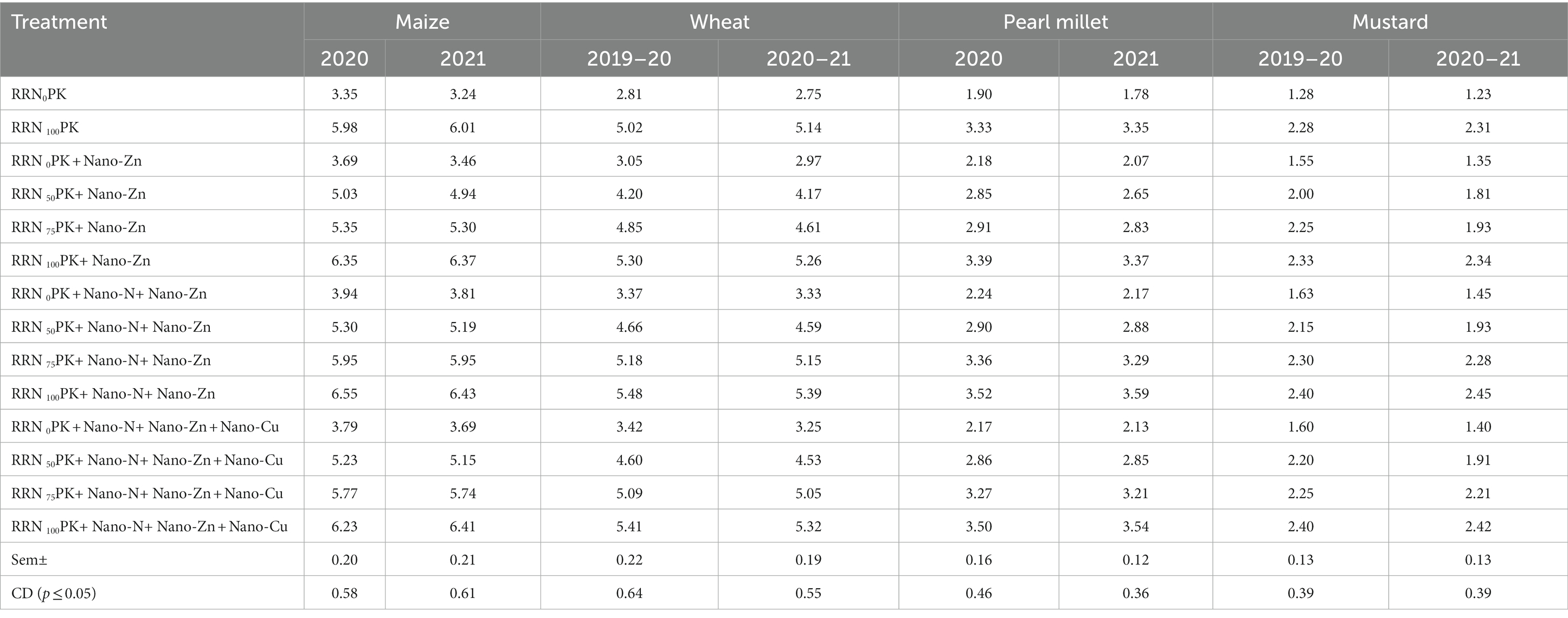
Table 3. Effect of nano-fertilizers on productivity (t ha−1) of maize, wheat, pearl millet, and mustard systems.
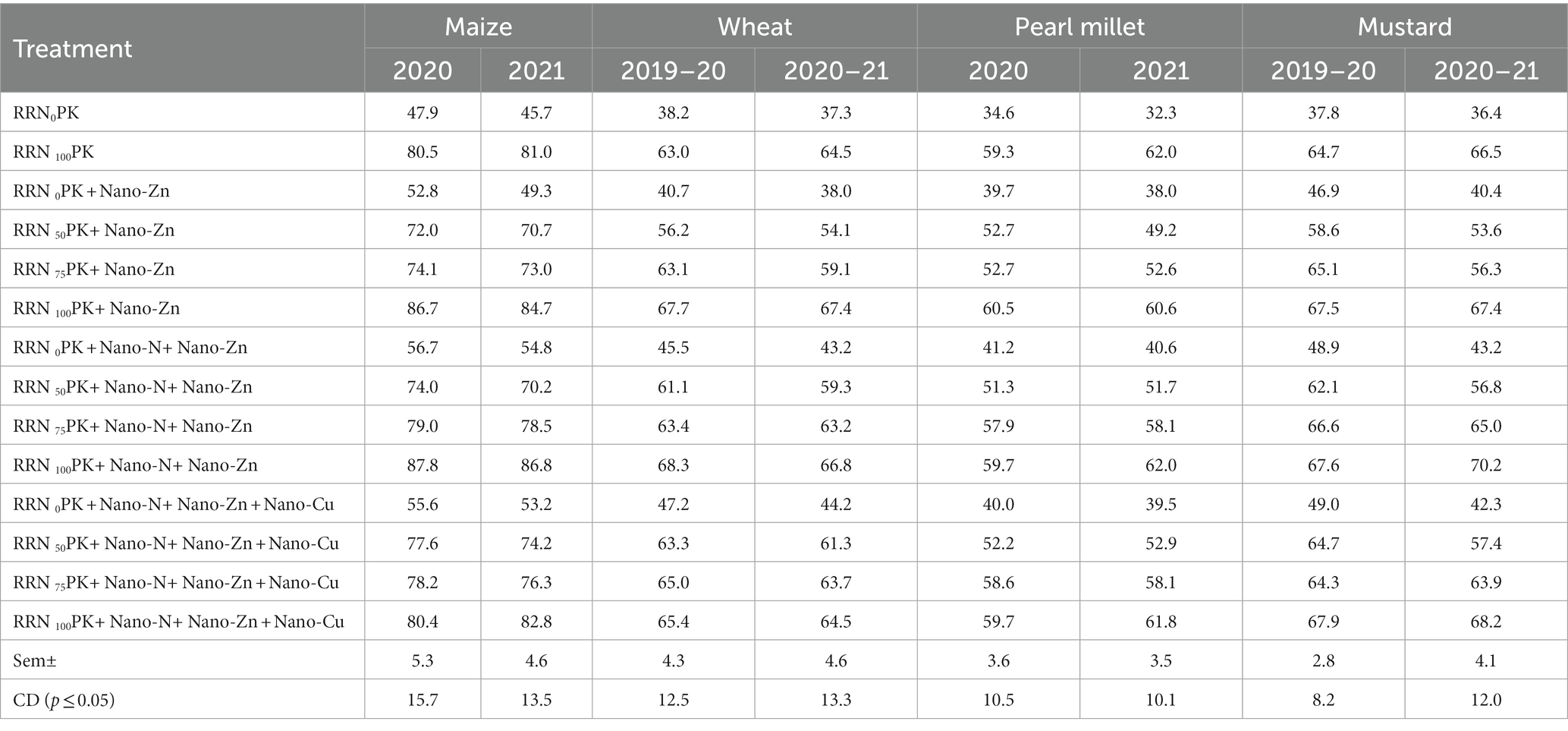
Table 4. Effect of nano-fertilizers on grain N uptake (kg ha−1) under maize-wheat and pearl millet-mustard systems.
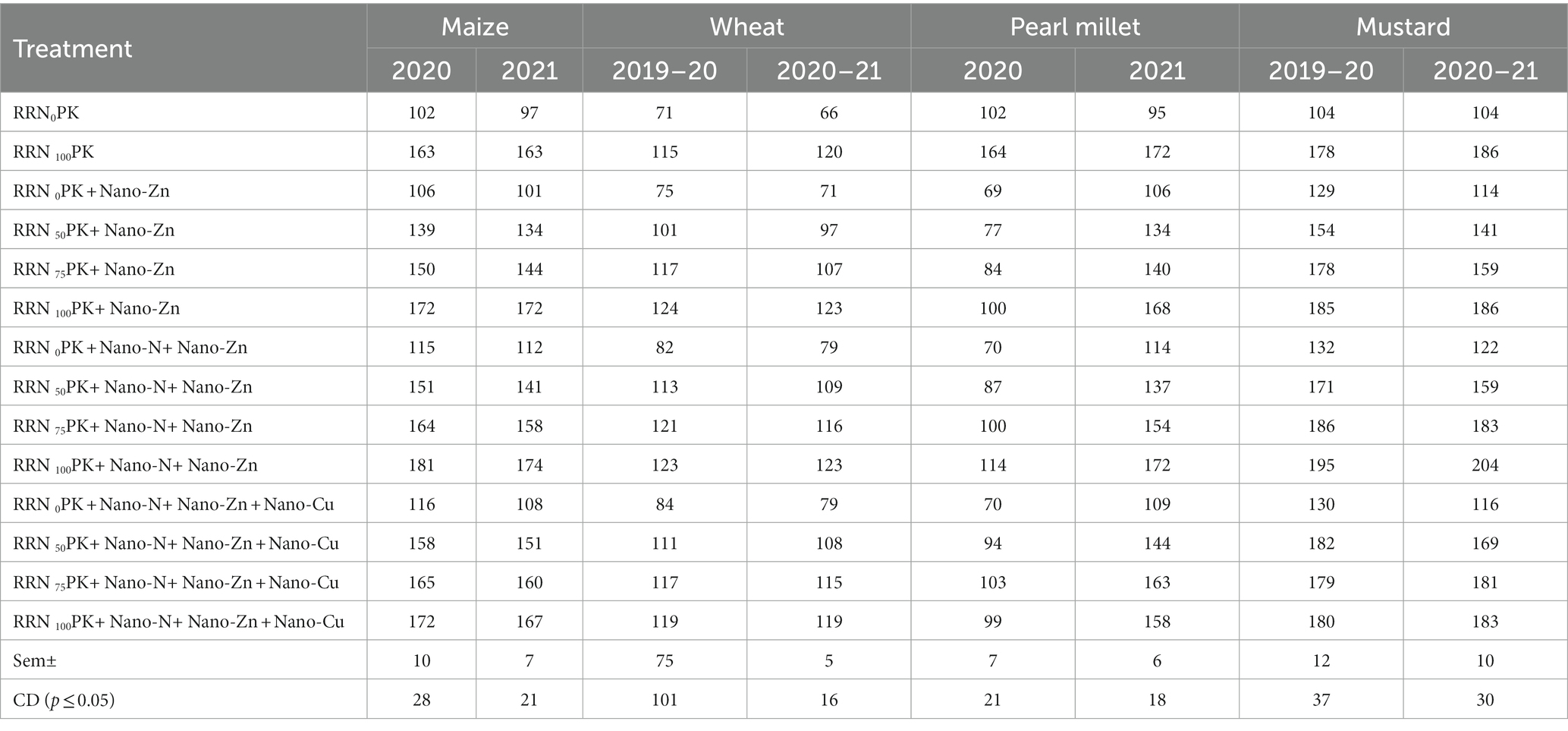
Table 5. Effect of nano-fertilizers on total (grain + straw/stover) N uptake (kg ha−1) under maize-wheat and pearl millet-mustard systems.
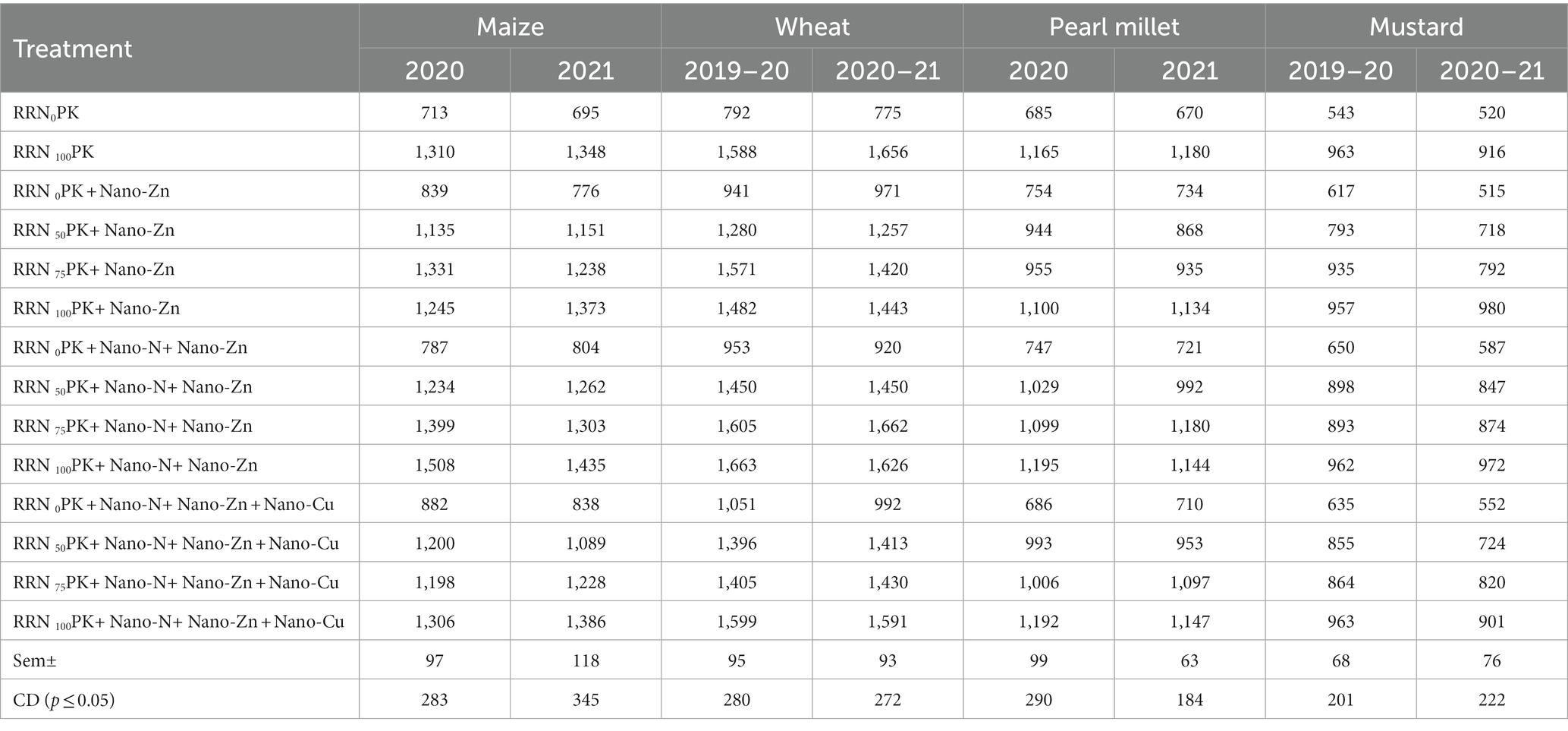
Table 6. Effect of nano-fertilizers on grain Zn uptake (mg ha−1) under maize-wheat and pearl millet-mustard systems.

Table 7. Effect of nano-fertilizers on total (grain + straw) Zn uptake (mg ha−1) under maize-wheat and pearl millet-mustard systems.
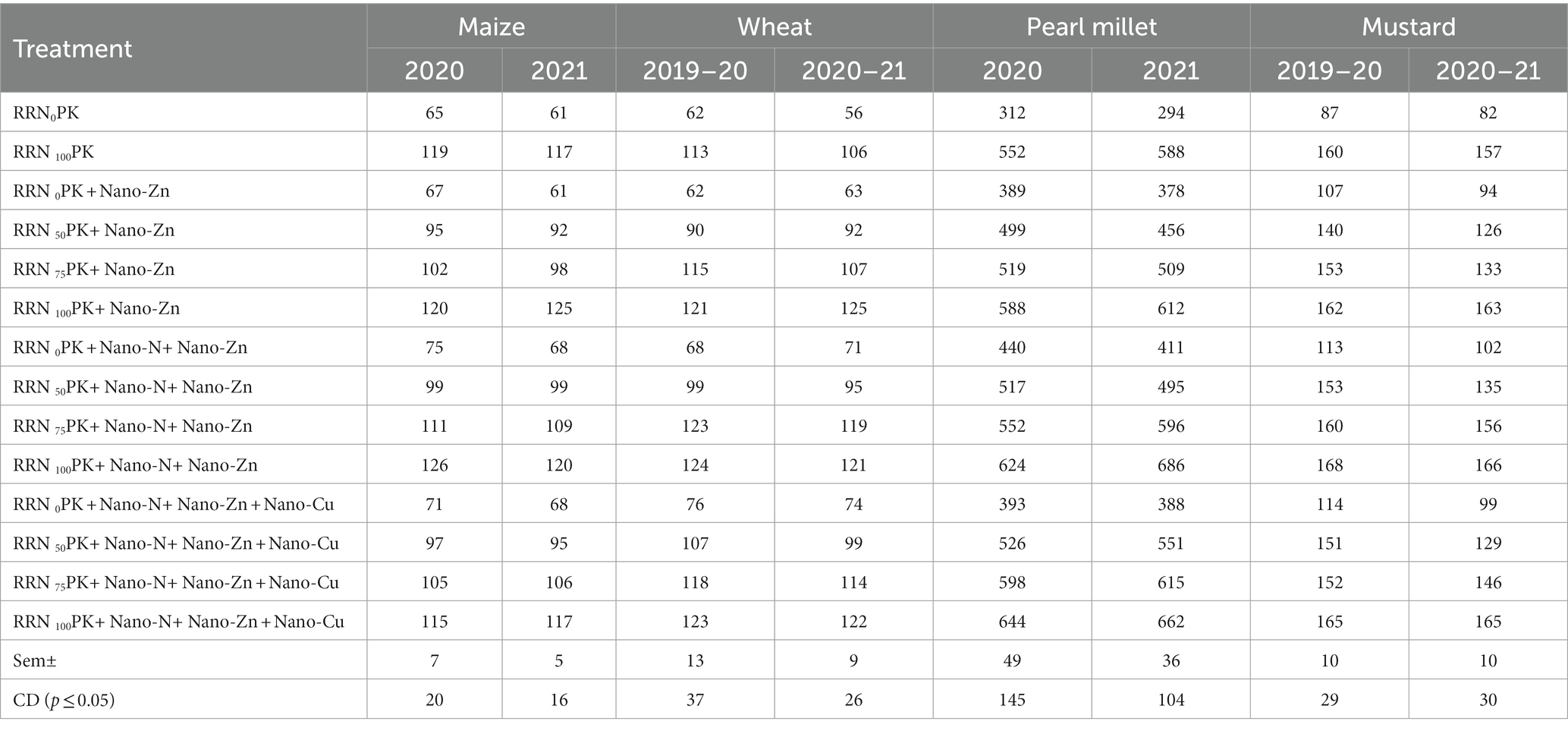
Table 8. Effect of nano-fertilizers on grain Cu uptake (mg ha−1) under maize-wheat and pearl millet-mustard systems.
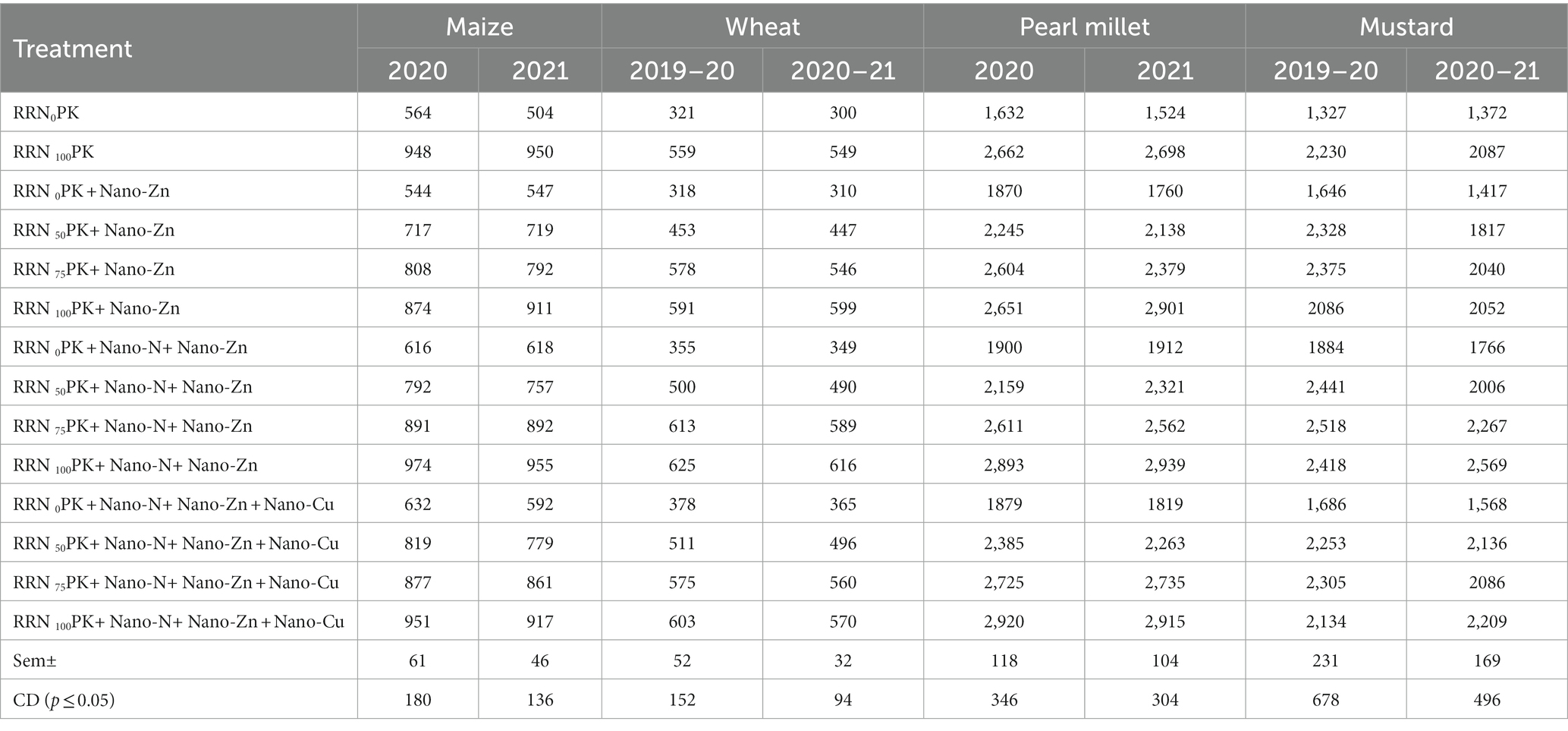
Table 9. Effect of nano-fertilizers on total Cu (grain + straw/stover) uptake (mg ha−1) under maize-wheat and pearl millet-mustard systems.
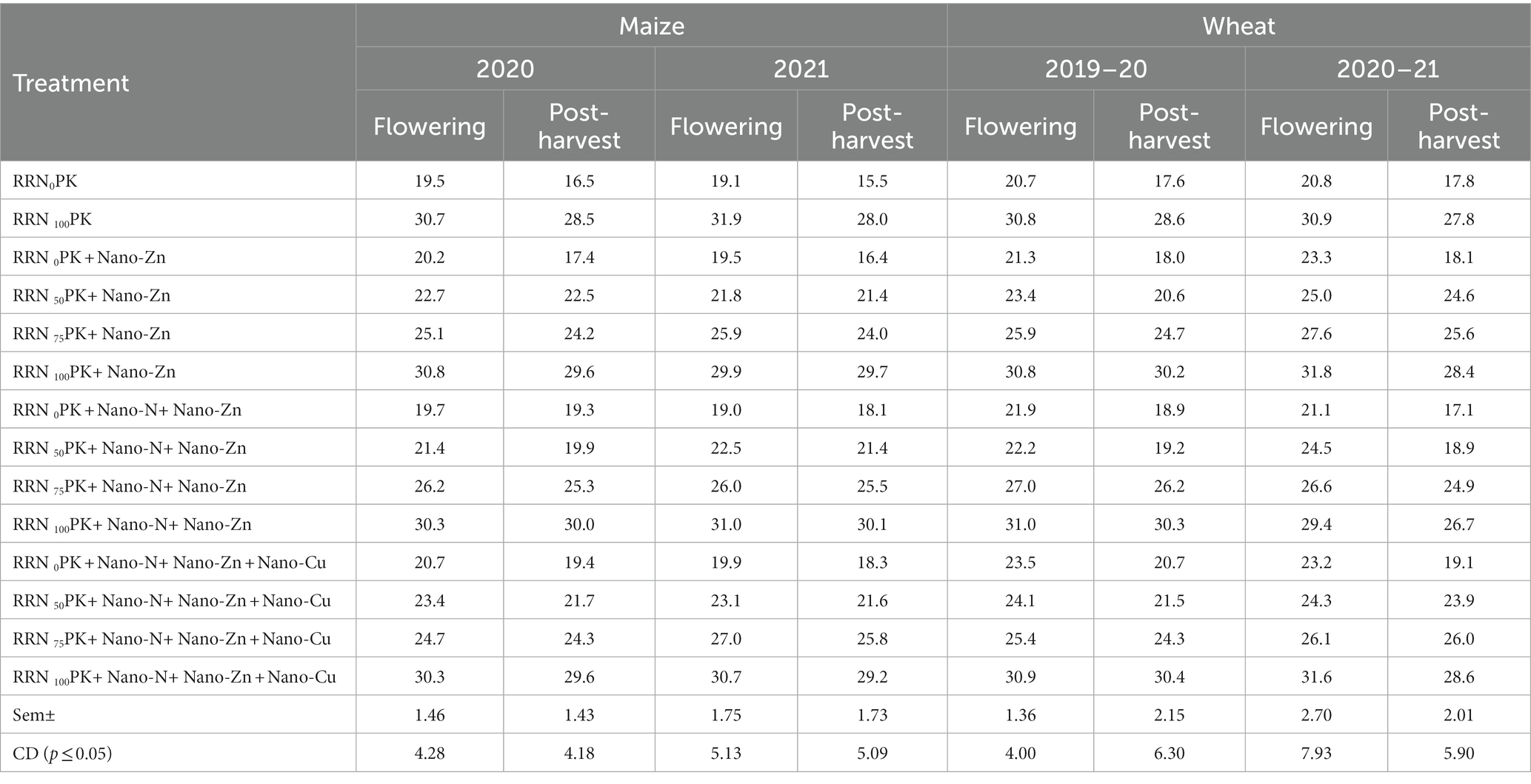
Table 10. Effect of nano-fertilizers on soil mineral nitrogen (μg/g of soil) at flowering and post-harvest stages of maize and wheat crops.

Table 11. Effect of nano-fertilizers on soil mineral nitrogen (μg/g of soil) at flowering and post-harvest stages of pearl millet and mustard crops.
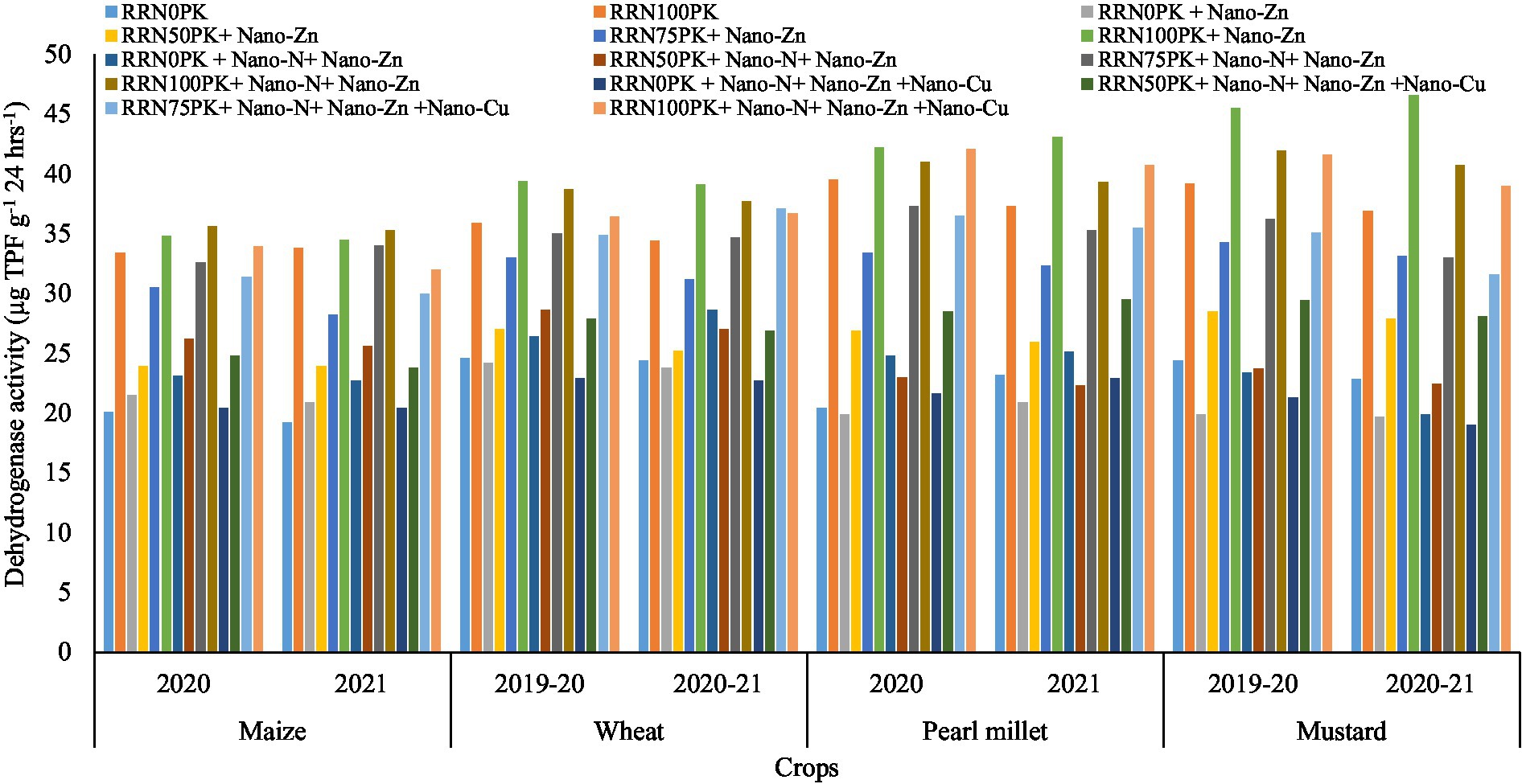
Figure 1. Effect of nano-fertilizers on dehydrogenase activity (μg TPF g−1 24 h−1) under maize-wheat and pearl millet-mustard systems.
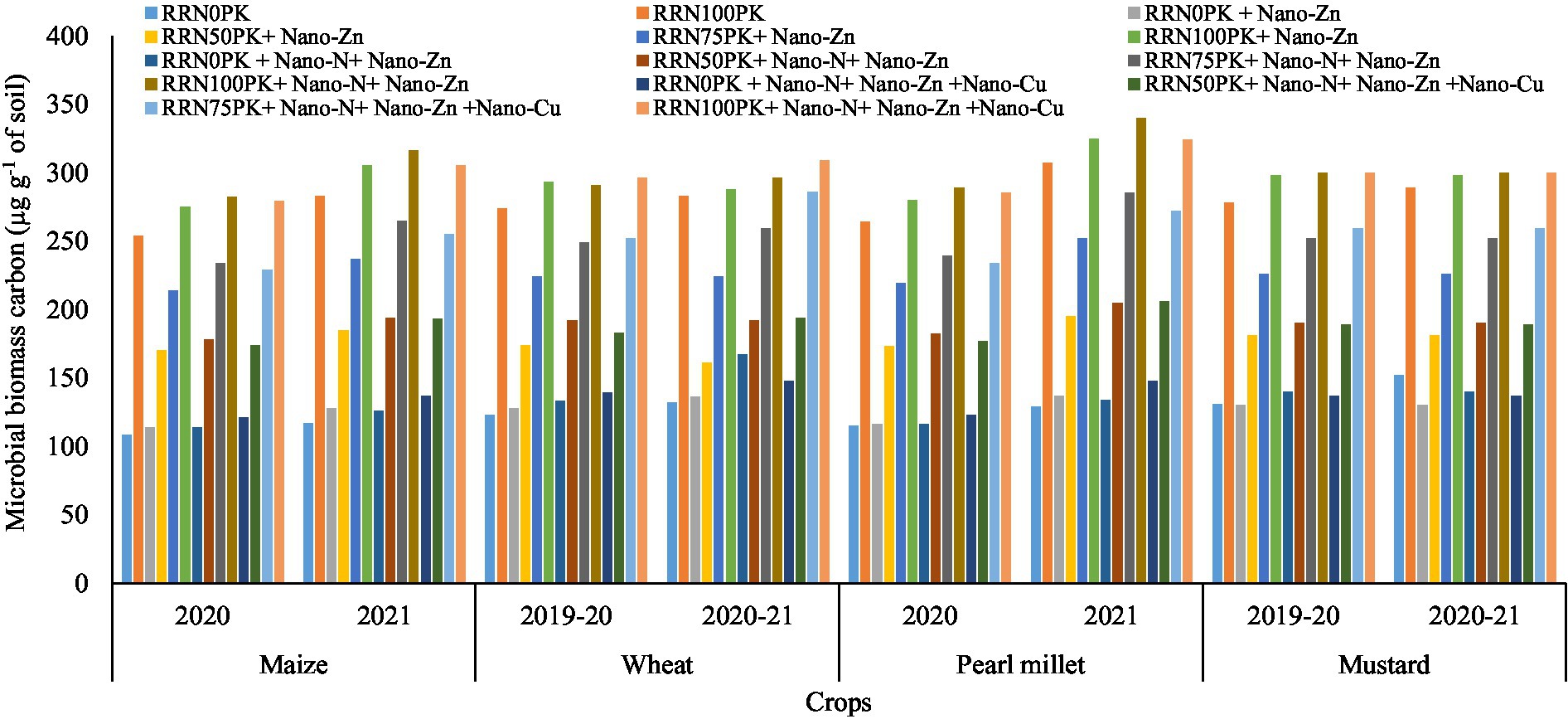
Figure 2. Effect of nano-fertilizers on Microbial biomass carbon (μg g−1 of soil) under maize-wheat and pearl millet-mustard systems.
3. Results
3.1. Productivity
Nano-fertilizers like N, Zn and Cu exerted a strong influence on both the grain and straw yield of maize-wheat and pearl millet-mustard systems during 2019–20 and 2020–21 crop seasons (Table 3). Nano-N + nano-Zn with 100% RRN applied plots recorded significantly higher grain yields of 6.55 and 6.43 t ha−1, 5.48 and 5.39 t ha−1, 3.52 and 3.59 t ha−1, and 2.40 and 2.45 t ha−1 in maize, wheat, pearl millet and mustard crops during first and second years, respectively over control (N0PK or N0PK+ nano-N or N0PK+ nano-N+ nano-Zn or N0PK+ nano-N+ nano-Zn + nano-Cu). The percentage increase in yield under N100PK+ Nano-N+ Nano-Zn treatment was 72.1–84.1% in maize, 73.8–77.1% in wheat, 55.5–62.8% in pearl millet, and 50.3–73.3% in mustard over control plots (N0PK+ nano-N+ nano-Zn). Likewise, there was 66.2–68.8%, 62.6–61.9%, 57.1–65.4%, and 47.2–69.0% yield enhancement was noted in maize, wheat, pearl millet and mustard crops, respectively under N100PK+ Nano-Zn treatment over N0PK + nano-Zn. Similarly, combination of all the three nano fertilizers like, nano-N + Zn + Cu with 100% RRN enhanced maize grain yield by 64.4–73.7%, wheat yield by 58.2–63.7%, pearl millet yield by 61.3–66.2%, and mustard yield by 50.0–72.9% over control plots (N0PK + Nano-N+ Nano-Zn + Nano-Cu). Therefore, sole application of nano-Zn or in combination with nano-N had higher yield advantage in all the crops compared to combination of all the three nano-fertilizers. However, in all the crops during both the study years, treatment with100% RRN with sole application of nano-Zn or a combination of nano-N+ Nano-Zn was found to be at par with 75% RRN + Nano-N + Nano-Zn. Likewise, the percentage yield enhancement with 75% RRN + nano-N + nano-Zn was 51.0–56.2% in maize, 53.7–54.7% in wheat, 50.0–51.6% in pearl millet, and 41.1–57.2% in mustard crops over control (N0PK + Nano-N+ Nano-Zn) during both the study years. The application of RRN100PK+ nano-N+ nano-Zn + nano-Cu led to slightly lower yields in all crops compared to RRN100PK+ nano-N and nano-Zn, although these results were statistically comparable (Table 3). Furthermore, a contrast analysis (between RRN0PK + Nano-N+ Nano-Zn Vs. RRN0PK + Nano-N+ Nano-Zn + Nano-Cu; RRN75PK+ Nano-N+ Nano-Zn Vs. RRN75PK+ Nano-N+ Nano-Zn + Nano-Cu; RRN100PK+ Nano-N+ Nano-Zn Vs. RRN10PK+ Nano-N+ Nano-Zn + Nano-Cu) was performed to elucidate the individual effect of nano-Cu from that of nano-N and nano-Zn, aiming to understand any potential antagonistic interactions (Supplementary Table 2). It was observed that the effect on nano-Cu in all the treatment combinations was non-significant in all the crops.
3.2. Profitability
Across various crop types, the highest cultivation costs were recorded in plots treated with 100% recommended rate of nitrogen (RRN) along with nano-N + nano-Zn + nano-Cu application, with values of 570, 507, 379, and 397 US$ ha−1 for maize, wheat, pearl millet, and mustard crops, respectively (Supplementary Table 1). Furthermore, the maximum net returns were observed in plots treated with 100% RRN along with nano-N + nano-Zn application for all crops, amounting to 996, 866, 898, and 1,209 US$ ha−1 for maize, wheat, pearl millet, and mustard crops, respectively. Notably (p ≤ 0.05), maize exhibited significantly higher net returns (996 US$ ha−1) and a Benefit–Cost ratio (B: C) of 2.77 under the 100% RRN along with nano-N + nano-Zn treatment, compared to the control (net return of 314 US$ ha−1 and B: C of 1.65). This performance remained comparable to the RRN75PK + Nano-N + Nano-Zn, RRN100PK, RRN100PK + Nano-Zn, and RRN100PK + Nano-N + Nano-Zn + Nano-Cu treatments (Supplementary Table 1).
Wheat demonstrated a notably elevated net return of 866 US$ ha−1 under the RRN100PK + Nano-N + Nano-Zn treatments, in stark contrast to the control group’s net return of 272 US$ ha−1. This performance remained on par with other treatments: RRN75PK + Nano-N + Nano-Zn (804 US$ ha−1), RRN100PK (816 US$ ha−1), RRN100PK + Nano-Zn (843 US$ ha−1), and RRN100PK + Nano-N + Nano-Zn + Nano-Cu (841 US$ ha−1) (Supplementary Table 1). Additionally, the statistical analysis unveiled a higher B: C of 2.76 under the RRN100PK treatment, surpassing the control’s B: C of 1.63. This performance was consistent with the B: C observed under RRN75PK + Nano-N + Nano-Zn (2.63), RRN100PK + Nano-N + Nano-Zn (2.73), and RRN100PK + Nano-N + Nano-Zn + Nano-Cu (2.66) treatments.
The treatment involving RRN100PK + Nano-N + Nano-Zn exhibited significantly elevated net returns in pearl millet, reaching 898 US$ ha−1, in contrast to the control’s net return of 374 US$ ha−1. This performance remained consistent with the net returns observed under RRN75PK + Nano-N + Nano-Zn (816 US$ ha−1), RRN100PK (863 US$ ha−1), RRN100PK + Nano-Zn (841 US$ ha−1), and RRN100PK + Nano-N + Nano-Zn + Nano-Cu (877 US$ ha−1) treatments (Supplementary Table 1). Furthermore, the analysis revealed a statistically higher B: C of 3.41 under the RRN100PK treatment, surpassing the control’s B: C of 2.18. This B: C performance remained consistent with the ratios observed under RRN100PK + Nano-Zn (3.36), RRN75PK + Nano-N + Nano-Zn (3.21), and RRN100PK + Nano-N + Nano-Zn + Nano-Cu (3.31) treatments.
Net return in mustard was registered higher under RRN100PK+ Nano-N+ Nano-Zn treatments (1,209 US $ ha−1) over control (509 US $ ha−1) and it was remained at par with RRN75PK+ Nano-N+ Nano-Zn (1,120 US $ ha−1), RRN100PK (1,156 US $ ha−1), RRN100PK+ Nano-Zn (1,157 US $ ha−1) and RRN100PK+ Nano-N+ Nano-Zn + Nano-Cu (1,183 US $ ha−1) (Supplementary Table 1). Significantly higher B: C was noticed under RRN100PK treatment (4.28) over control (2.54) and it was remained at par with RRN75PK+ Nano-N+ Nano-Zn (3.90), RRN100PK+ Nano-Zn (4.09), RRN100PK+ Nano-N+ Nano-Zn (4.10), and RRN100PK+ Nano-N+ Nano-Zn + Nano-Cu (3.98).
3.3. Nitrogen uptake
In all crop seasons, maize, wheat, pearl millet and mustard grains exhibited significantly higher N uptake during the study years. In general, nano-N + nano-Zn with 100% RRN had higher N uptake [(87.8 and 86.8 kg ha−1 in maize during first and second year, respectively), (68.3 and 66.8 kg ha−1 in wheat during first and second year, respectively), (59.7 and 62.0 kg ha−1 in pearl millet during first and second year, respectively) and (67.6 and 70.2 kg ha−1 in mustard during first and second year, respectively)] over control (N0PK). However, sole or combination of nano-fertilizers had similar grain N-uptake in mustard crop during both the study years (Table 4). In maize and wheat crops, maximum N uptake of 86.8–87.8 kg ha−1, and 68.3–66.8 kg ha−1, respectively was recorded with 100% RRN + nano-N + nano-Zn plots over other combinations. However, superior treatment was at par with other treatments as compared to N0PK + Nano-Zn, N0PK + Nano-N + Nano-Zn, and N0PK + Nano-N + Nano-Zn + Nano-Cu during both the cropping seasons. Likewise, application of 100% RRN + Nano-Zn recorded significantly higher grain N uptake of 60.5 kg ha−1 in pearl millet during 2019–20, while it was comparatively higher in 100% RRN + Nano-N + Nano-Zn (62.0 kg ha−1) during 2020–21 than other nano-fertilizer applied plots. Furthermore, the treatments with 75% RRN + Nano-N+ Nano-Zn, and 75% RRN + Nano-N + Zn + Cu with 100% RRN + nano fertilizers applied plots registered the slightly lesser but similar grain N uptake in all the crops during all the study years. In mustard, the treatment 100% RRN + nano-N + nano-Zn + nano-Cu registered the higher grain N uptake by 67.9–70.2 kg ha−1 over other treatments during both the study years.
Total N uptake (grain + stover/straw) in maize, wheat, pearl millet and mustard crops were significantly influenced by nano fertilizer application. Application of nano-N + nano-Zn along with 100% RRN had higher total N uptake by 174–181 kg ha−1 in maize, ~123 kg ha−1 in wheat, 114–172 kg ha−1 in pearl millet, and 195–204 kg ha−1 in mustard over other combinations of nano-fertilizers with 100% RRN plots as well as in lower levels of fertilizer application, but it was at par with 75% RRN levels (Table 5).
3.4. Zn uptake
In comparison to the other combinations of nano-fertilizers with 100% RRN plots, the Zn uptake with nano-N + nano-Zn was greater than 1,100 mg ha−1 in maize, wheat and pearl millet crops, while it was >900 mg ha−1 in mustard (Table 6). Zinc uptake was significantly higher with 100% RRN + Nano-N + Nano-Zn plots, and the Zn uptake was higher by 1,435–1,508 mg ha−1 in maize, 1,626–1,195 kg ha−1 in wheat, 1,144–1,195 mg ha−1 in pearl millet, and 962–972 mg ha−1 in mustard over other treatments. However, application of 75% RRN along with nano-N + nano-Zn was at par with Zn uptake of 100% RRN + nano-N + nano-Zn applied plots. Interestingly, all the three combinations of nano-fertilizers like nano-N + nano-Zn + nano-Cu exhibited lower Zn uptake in grains of all the crops as compared to combination of nano-N + nano-Zn during the study years.
When applied to maize, wheat, pearl millet and mustard, nano fertilizers dramatically increased total Zn uptake (grain + straw/stover) and irrespective of crops, >52–62% of that Zn was retained in the straw over grain/seed (Table 7). Likewise, Zn uptake was significantly higher with 100% RRN+ Nano-N+ Nano-Zn plots in all the tested crops like maize (5636–5,670 mg ha−1), wheat (2753–2,843 kg ha−1), pearl millet (4386–4,603 mg ha−1), and in mustard (4520–4,635 mg ha−1; Table 7). However, it was at par with 75% RRN+ Nano-N+ Nano-Zn applied plots in all the crops.
3.5. Cu uptake
Over the years, harvests of maize, wheat, pearl millet, and mustard have all seen considerable increases in grain Cu consumption with 100% RRN applied plots (Table 8). However, application of nano-N + Zn + Cu either in alone or in combination had little effect in Cu uptake in maize, wheat and mustard crops, while slight variation in Cu uptake was observed in pearl millet crop. The variation of only about 2–4 mg ha−1 was observed in all the crops with respect to nano-fertilizer application. However, the uptake of Cu in pearl millet plant was 3–4 times higher than maize, wheat and mustard crops. Similarly, total Cu uptake by all the crops also followed the same trend as that of grain Cu uptake during the study years (Table 9). However, total plant Cu uptake was significantly higher in 100% RRN + nano-N + nano-Zn applied plots in maize, wheat and mustard crops as compared to other combinations. Whereas, 100% RRN + nano-N + nano-Zn + nano-Cu applied plots had significantly higher total Cu uptake in pearl millet than other combination of fertilizers.
3.6. Soil mineral nitrogen
The data presented in Table 10 indicated that the soil mineral nitrogen in maize, wheat, pearl millet and mustard crops was significantly influenced by nano-fertilizer application at different sampling times during both the study years. Soil mineral nitrogen ranged from 16.4–30.1 μg g−1 of soil during flowering and post-harvest stages in maize crop. Application of 100% RRN + Nano-Zn, and 100% RRN + Nano-N + Nano-Zn exhibited significantly higher values for soil mineral N uptake at flowering (30.8–31.0 μg/g of soil) and post-harvest soils (30.0–31.1 μg/g of soil) than other combinations, and it was at par with 100% RRN+ Nano-N+ Nano-Zn + Nano-Cu. While the variation in soil mineral N was slightly higher in wheat than maize. Mineral N in soil varied significantly from 17.1 to 31.6 μg/g of soil in wheat (Table 10). Among growth stages of wheat, application of 100% RRN+ Nano-N+ Nano-Zn recorded significantly higher mineral N at flowering (31.0 μg/g) and at post-harvest soils (30.3 μg/g) over other plots during 2019–20. During 2020–21, application of 100% RRN+ Nano-N+ Nano-Zn + Nano-Cu (31.6 and 28.6 μg/g of soil at flowering and post-harvest stages, respectively) noted maximum values for mineral nitrogen and remained at par with almost all the other treatments except treatments N0PK + Nano-Zn and N0PK + Nano-N+ Nano-Zn + Nano-Cu.
Mineral nitrogen in pearl millet during 2019–20 and 2020–21, at flowering and post-harvest stages ranged from 17.7 to 32.3 μg/g of soil (Table 11). Application of 100% RRN + Nano-Zn and 100% RRN+ Nano-N+ Nano-Zn + Nano-Cu noted the highest values for soil mineral N of 32.0 and 31.0 μg/g, 32.3 and 30.7 μg/g soil at flowering and post-harvest stages, respectively during the studied seasons and recorded comparable values of mineral nitrogen with treatments 75% RRN + Nano-Zn, 75% RRN+ Nano-N + Nano-Zn, 100% RRN + Nano-N + Nano-Zn and 75% RRN + Nano-N + Nano-Zn + Nano-Cu in both the years, respectively. Significant variation in soil mineral nitrogen in mustard crop was recorded and ranged from 20.1 to 33.3 μg/g of soil (Table 11). Adoption of 100% RRN + Nano-Zn registered highest value for soil mineral N at flowering (~33.1 μg/g soil) and 100% RRN+ Nano-N + Nano-Zn + Nano-Cu at post-harvest stages (~32.3 μg/g soil), respectively during both the study years and it was at par with 75% RRN + Nano-N + Nano-Zn, 100% RRN + Nano-N + Nano-Zn and 75% RRN + Nano-N + Nano-Zn + Nano-Cu.
3.7. Dehydrogenase activity
Dehydrogenase activity (DHA) of soil under different treatments was measured in maize-wheat and pearl millet-mustard systems (Figure 1). In maize, maximum DHA activity was recorded under treatment of 100% RRN + nano-N + nano-Zn (35.5 μg TPF g−1 24 h−1, average of 2 years) which remained at par with 100% RRN+ Nano-N + Nano-Zn + Nano-Cu and 75% RRN + Nano-N + Nano-Zn. The treatment 100% RRN + Nano-Zn registered similar dehydrogenase activity (34.7 μg TPF g−1 24 h−1, average of 2 years) and also remained at par with treatment 100% RRN+ Nano-N + Nano-Zn. The maximum dehydrogenase activity was recorded under 100% RRN + nano-Zn treatment (39.3 μg TPF g−1 24 h−1 for wheat, 42.2 μg TPF g−1 24 h−1 for pearl millet, 46.1 μg TPF g−1 24 h−1 for mustard, average of 2 years) and it remained at par with 100% RRN + nano-N + nano-Zn (38.2 μg TPF g−1 24 h−1 for wheat, 40.2 μg TPF g−1 24 h−1 for pearl millet, 41.3 μg TPF g−1 24 h−1 for mustard, average of 2 years) and 100% RRN + nano-N + nano-Zn + nano-Cu (36.7 μg TPF g−1 24 h−1 for wheat, 42.4 μg TPF g−1 24 h−1 for pearl millet, 40.3 μg TPF g−1 24 h−1 for mustard, average of 2 years).
Furthermore, the treatments 75% RRN + Nano-Zn (32.1 μg TPF g−1 24 h−1for wheat, average of 2 years), 75% RRN + Nano-N + Nano-Zn (34.9 μg TPF g−1 24 h−1for wheat, 36.3 μg TPF g−1 24 h−1for pearl-millet, average of 2 years) and 75% RRN + Nano-N + Nano-Zn + Nano-Cu (36.0 μg TPF g−1 24 h−1 for wheat, 36.1 μg TPF g−1 24 h−1 for pearl-millet, average of 2 years) also remained at par with 100% RRN + Nano-N + Nano-Zn during the 1st and 2nd years, respectively.
3.8. Soil microbial biomass carbon
A significant effect on soil microbial biomass carbon was recorded under various treatments of maize-wheat and pearl millet-mustard system (Figure 1). Application of 100% RRN + Nano-N + Nano-Zn recorded maximum value for microbial biomass carbon for maize (282–316 μg g−1 of soil), wheat (291–296 μg g−1 of soil), pearl-millet and Mustard (289–349 μg g−1 of soil) during first as well as second year, while application of 100% RRN + Nano-Zn recorded maximum value for microbial biomass carbon during first year in wheat crop (293 μg g−1 of soil) (Figure 2). The treatments 100% RRN + Nano-Zn and 100% RRN + Nano-N + Nano-Zn + Nano-Cu recorded comparable values for microbial biomass carbon for maize, wheat and pearl millet during 2019–2020 and 2020–2021. In mustard, during 2019–2020 and 2020–2021, application of 100% RRN + Nano-N + Nano-Zn and 100% RRN + Nano-N + Nano-Zn + Nano-Cu recorded the highest and same values (300 μg g−1 of soil) for soil microbial biomass but did not show any significant difference (Figure 1). Both the treatments remained at par among themselves and with treatments 100% RRN + Nano-Zn (298 μg g−1 of soil), 75% RRN + Nano-N+ Nano-Zn (252 μg g−1 of soil), and 75% RRN+ Nano-N+ Nano-Zn + Nano-Cu (259 μg g−1 of soil) during both the years.
4. Discussion
4.1. Productivity of crops
Overuse of conventional fertilizers is a globally followed practice to meet plant nutrient needs. However, the efficiency of fertilizer use in crops rarely exceeds 30–35%, which is due to the loss of nutrient through leaching, evaporation and fixation (Mahmud et al., 2021). Therefore, nano-fertilizers have gained momentum over the decade to make fertilizer use more efficient and facilitate fertilizer application. However, research has evolved over a decade from laboratory studies and concentric pot experiments. Few systematic studies have been conducted so far to demonstrate the effects of nano-fertilizers or the combination of nano-fertilizers with conventional fertilizers on crop yield and economics under the field conditions (Kah et al., 2018; Hu and Xianyu, 2021; Upadhyay et al., 2023).
The application of 100% RRN in conjunction with nano-N + nano-Zn increased grain yields by 66.2–68.8% in maize, 62.6–61.9% in wheat, 57.1–65.4% in pearl millet, and 47.2–69.0% in mustard compared to control plots. However, for maize, wheat, pearl millet, and mustard, 75% RRN combined with two sprays of Nano-urea + nano-Zn produced statistically equivalent yields to 100% RRN + nano-N + nano-Zn (Table 3). This increase in crop yield with the application of nano-N + nano-Zn could be attributed to increased uptake of applied nano-fertilizers in addition to the basal application of traditional fertilizers. Foliar use of nano-fertilizers at important crop growth stages in various crops, either alone or in conjunction with fertilizers, boosts the crop yield (Kumar et al., 2021). According to Al-Juthery et al. (2019), foliar spraying of nano-fertilizers considerably increased plant growth parameters and yield of maize and wheat crops. Nano-urea, nano-Zn, and nano-Cu were sprayed on leaves in the current investigation, resulting in direct penetration through stomatal holes, and transfer through plasmodesmata (Kumar et al., 2021). Similarly, 75% RRN alone or in conjunction with nano-N + Nano-Zn was determined to be equivalent to 100% RRN+ Nano-N + Nano-Zn. Although maize, wheat, pearl millet, and mustard yields were statistically equal during the first year, yield was significantly lower under 75% RRN than 100% RRN during the second study year. This could be related to a deterioration in the soil’s intrinsic fertility state, which contributed N nutrition to both crops during the first year (the year the experiment began). These nano-fertilizers release N and Zn in a regulated manner after entering plant systems. The absorption efficacy of nano-urea by plants is 80% greater than that of regular urea (Kumar et al., 2021). However, the efficiency of these nano-fertilizers is dependent on their concentration, application method, and also on the weather conditions. According to Babu et al. (2022), in warm weather better acquisition and translocation of nano-urea results in achieving higher efficiency of nano-urea by plants. Interestingly, the use of ZnO nano particles (NPs) enhanced gas exchange parameters and chlorophyll concentration, leading to a better photosynthetic rate (Srivastav et al., 2021). As a result, either alone or in combination with nano-N, nano-Zn delivered a higher yield advantage. Zn has already been shown to improve chlorophyll synthesis by stimulating chlorophyll pigment formation and protochlorophyllide development, which ultimately improve photosynthesis (Sadak and Bakry, 2020; Del-Buono et al., 2021; Salam et al., 2022).
4.2. Uptake of nutrients
Regardless of crop, the application of nano-fertilizers with 100% RRN + Nano-N + Nano-Zn plots increased N and Zn uptake (Tables 4–7). However, the use of 75% RRN in conjunction with nano-N + nano-Zn produced comparable N and Zn uptake to that of 100% RRN + nano-N + nano-Zn plots. This was mostly attributable to the statistically same level of productivity noticed in all crops under mentioned treatments compared to statistically at par N and Zn levels. It implies that the application of nano-urea as a foliar spray additionally stimulates the uptake mechanism. Nano-N absorption is dependent on the leaf surface area (Babu et al., 2022), plant nutritional needs (Tarafdar et al., 2012), applied N (Grillo et al., 2021), and usage efficiency of native soil N (Tarafdar et al., 2014). In this work, Zn nano fertilizers and nano-N dramatically increased Zn uptake in all crops. As a result, our research enables us to decipher the Zn nano-fertilizer, allowing it to be used as an effective growth regulator to boost crop output under stress situations. Salam et al. (2022) discovered that adding ZnO NPs to maize plants decreased Co stress by lowering its uptake and bioaccumulation, boosting critical nutrient intake, and improving photosynthetic efficiency. Interestingly all the three combinations of nano-fertilizers like nano-N + nano-Zn + nano-Cu had similar Cu uptake with no nano-Cu applied plots (Tables 8, 9).
4.3. Mineral nitrogen and biological activities
Soil mineral nitrogen (Tables 10, 11), dehydrogenase activity (DHA) (Figure 1), and soil microbial biomass carbon (SMBC) (Figure 2) in maize, wheat, pearl millet, and mustard crops were significantly higher with the application of 100% RRN + Nano-N + Nano-Zn at flowering and post-harvest soils than other combinations. As a result, using Zn nano-fertilizers in conjunction with nano-N in addition to traditional fertilizers provided a greater advantage in terms of increasing DHA and SBMC. Zinc (Zn) is an essential element which involved in photosynthesis, the antioxidant defense system, and disease resistance (Olechnowicz et al., 2018; Cabot et al., 2019). Post-flowering applications of ZnO NPs had a larger effect on grain Zn content and a relatively lesser impact on grain yield was reported by Dapkekar et al. (2018) and Srivastav et al. (2021). In the current study, the applications of 100% RRN and 75% RRN + Nano-N + nano-Zn yielded statistically similar mineral N values throughout the seasons, implying that nutrient mining did not occur. The superior plots’ increased root biomass frequently serves as a substrate for microbial development and metabolism. The addition of nano-urea increased root development and activity, which favored soil enzymatic activity. Nevertheless, the recommended N applications, along with Nano-N and Nano-Zn spray, produced the highest soil mineral N levels. However, lesser or no application of conventional fertilizers resulted in significantly lower mineral N, DHA, and SMBC levels across the seasons. Therefore, to avoid nutrient mining, at least 75% of the recommended nitrogen along with 2 sprays of nano-urea or nano-urea and nano-Zn should be applied. Further, it is observed from the study that maintaining ecological balance between aboveground (in terms of plant growth and yield) and underground (soil mineral N, DHA, SMBC etc.) the conjoint use of conventional fertilizers and nano-fertilizer (nano-N and nano-Zn) could be one of the best option.
5. Conclusion
The use of nano-N and nano-Zn in combination with traditional nitrogen fertilizers has immense scope to improve crop yields, nutrient uptake, soil mineral N, dehydrogenase activity, and soil microbial biomass carbon in wheat-maize and mustard-pearl millet cropping systems. Maximum grain yield of maize, wheat, pearl millet and mustard crops was observed under RRN 100PK+ Nano-N+ Nano-Zn treatments. The alone application of nano-Zn or nano-N+ nano-Zn or nano-N+ nano-Zn + nano-Cu could not suffice the requirement of the crops. Basal N application (75% of recommended) through prilled urea with full dose of P2O5 and K2O along with nano-urea (2,500 mL ha−1 spray−1) + nano-Zn (1,250 mL ha−1) sprays recorded on par grain yield (wheat, mustard, maize and pearl millet) over 100% N + full dose of P2O5 and K2O (recommended dose of fertilizer). Furthermore, the application of nano-Cu did not produced any significant results concerning crops yield. Overall, continued exploration demands a rigorous pursuit of additional research and expansive field trials concerning nano fertilizers, both in isolation and in tandem with conventional counterparts. It is imperative to carry out these endeavors across diverse crops and varied locations, a vital undertaking aimed at unraveling the true scope and potential of this innovative approach.
Data availability statement
The original contributions presented in the study are included in the article/Supplementary material, further inquiries can be directed to the corresponding author.
Author contributions
PU: Conceptualization, Funding acquisition, Investigation, Methodology, Project administration, Resources, Writing – original draft, Writing – review & editing. VS: Conceptualization, Methodology, Writing – original draft. GR: Data curation, Formal analysis, Methodology, Writing – review & editing. BD: Investigation, Methodology, Project administration, Writing – review & editing. AD: Data curation, Formal analysis, Methodology, Supervision, Writing – original draft. RS: Data curation, Validation, Writing – review & editing. SR: Data curation, Formal analysis, Writing – review & editing. KS: Data curation, Formal analysis, Writing – original draft, Writing – review & editing. SB: Data curation, Formal analysis, Validation, Visualization, Writing – review & editing. TS: Funding acquisition, Resources, Writing – review & editing. YK: Funding acquisition, Resources, Writing – review & editing. CS: Data curation, Resources, Writing – review & editing. MR: Data curation, Methodology, Writing – review & editing. AK: Resources, Writing – review & editing. SS: Formal analysis, Writing – review & editing. SD: Formal analysis of data. SR: Writing – review & editing.
Funding
The research, and/or publication of this article received financial support from the Indian Farmers Fertiliser Cooperative Limited, New Delhi, India, under Grant number CRP 79-123.
Acknowledgments
The authors are highly thankful to the Director, IARI for providing necessary facilities for this investigation. The authors also expressed their amiable gratitude to Dhinu Yadav, Debarshi Dasgupta, and Manoj for their contribution in the project.
Conflict of interest
The authors declare that the research was conducted in the absence of any commercial or financial relationships that could be construed as a potential conflict of interest.
Publisher’s note
All claims expressed in this article are solely those of the authors and do not necessarily represent those of their affiliated organizations, or those of the publisher, the editors and the reviewers. Any product that may be evaluated in this article, or claim that may be made by its manufacturer, is not guaranteed or endorsed by the publisher.
Supplementary material
The Supplementary material for this article can be found online at: https://www.frontiersin.org/articles/10.3389/fsufs.2023.1260178/full#supplementary-material
References
Ahmed, B., Rizvi, A., Syed, A., Elgorban, A. M., Khan, M. S., Al-Shwaiman, H. A., et al. (2021). Differential responses of maize (Zea mays) at the physiological, biomolecular, and nutrient levels when cultivated in the presence of nano or bulk ZnO or CuO or Zn2+ or Cu2+ ions. J. Hazard. Mater. 419:126493. doi: 10.1016/j.jhazmat.2021.126493
Ali, S., Rizwan, M., Noureen, S., Anwar, S., Ali, B., Naveed, M., et al. (2019). Combined use of biochar and zinc oxide nanoparticle foliar spray improved the plant growth and decreased the cadmium accumulation in rice (Oryza sativa L.) plant. Environ. Sci. Pollut. Res. 26, 11288–11299. doi: 10.1007/s11356-019-04554-y
Al-Juthery, H. W. A., Hardan, H. M., Al-Swedi, F. G., Obaid, M. H., and Al-Shami, Q. M. N. (2019). Effect of foliar nutrition of nano-fertilizers and amino acids on growth and yield of wheat. Environ. Earth Sci. 388. doi: 10.1088/1755-1315/388/1/012046
Arough, Y., Seyed-Sharifi, R., and Seyed-Sharifi, R. (2016). Bio fertilizers and zinc effects on some physiological parameters of triticale under water-limitation condition. J. Plant Interact. 11, 167–177. doi: 10.1080/17429145.2016.1262914
Babu, S., Singh, R., Yadav, D., Rathore, S. S., Raj, R., Avasthe, R., et al. (2022). Nanofertilizers for agricultural and environmental sustainability. Chemosphere 292:133451. doi: 10.1016/j.chemosphere.2021.133451
Bartolucci, B., Scognamiglio, V., Antonacci, A., and Fraceto, L. F. (2022). What makes nanotechnologies applied to agriculture green? Nano Today 43, 1–5. doi: 10.1016/j.nantod.2022.101389
Behera, S. K., Shukla, A. K., Prakash, C., Tripathi, A., Kumar, A., and Trivedi, V. (2021). Establishing management zones of soil Sulphur and micronutrients for sustainable crop production. Land Degrad. Dev. 32, 3614–3625. doi: 10.1002/ldr.3698
Cabot, C., Martos, S., Llugany, M., Gallego, B., Tolrà, R., and Poschenrieder, C. (2019). A role for zinc in plant defense against pathogens and herbivores. Front. Plant Sci. 10:1171. doi: 10.3389/fpls.2019.01171
Casida, L. E. (1977). Microbial metabolic activity in soil as measured by dehydrogenase determinations. Appl. Environ. Microbiol. 34, 630–636. doi: 10.1128/aem.34.6.630-636.1977
Chen, J., Liu, X., Wang, C., Yin, S. S., Li, X. L., Hu, W., et al. (2015). Nitric oxide ameliorates zinc oxide nanoparticles-induced phytotoxicity in rice seedlings. J. Hazard. Mater. 297, 173–182. doi: 10.1016/j.jhazmat.2015.04.077
Dapkekar, A., Deshpande, P., Oak, M. D., Paknikar, K. M., and Rajwade, J. M. (2018). Zinc use efficiency is enhanced in wheat through nanofertilization. Sci. Rep. 8:6832. doi: 10.1038/s41598-018-25247-5
Das, A., Babu, S., Yadav, G. S., Ansari, M. A., Singh, R., Baishya, L. K., et al. (2016). Status and strategies for pulses production for food and nutritional security in north-eastern region of India. Indian J. Agron. 61, 43–57.
Del-Buono, D., Di Michele, A., Costantino, F., Trevisan, M., and Lucini, L. (2021). Biogenic ZnO nanoparticles synthesized using a novel plant extract: application to enhance physiological and biochemical traits in maize. Nano 11:1270. doi: 10.3390/nano11051270
Dimkpa, C. O., Singh, U., Bindraban, P. S., Adisa, I. O., Elmer, W. H., Gardea-Torresdey, J. L., et al. (2019). Addition-omission of zinc, copper, and boron nano and bulk oxide particles demonstrate element and size-specific response of soybean to micronutrients exposure. Sci. Total Environ. 665, 606–616. doi: 10.1016/j.scitotenv.2019.02.142
Dong, Y., Fu, S., Li, H., and Jiang, G. (2022). Adsorption behaviors and mechanisms of Cu2+, Zn2+ and Pb2+ by magnetically modified lignite. Sci. Rep. 12:1394. doi: 10.1038/s41598-022-05453-y
Drostkar, E., Talebi, R., and Kanouni, H. (2016). Foliar application of Fe, Zn and NPK nano-fertilizers on seed yield and morphological traits in chickpea under rainfed condition. Res. Ecol. Lett. 4, 221–228.
Du, W., Yang, J., Peng, Q., Liang, X., and Mao, H. (2019). Comparison study of zinc nanoparticles and zinc sulphate on wheat growth: from toxicity and zinc biofortification. Chemosphere 227, 109–116. doi: 10.1016/j.chemosphere.2019.03.168
Fageria, N. K., Baligar, V. C., and Clark, R. B. (2002). Micronutrients in crop production. Adv. Agron. 77, 185–268. doi: 10.1016/S0065-2113(02)77015-6
Grillo, R., Mattos, B. D., Antunes, D. R., Forini, M. M., Monikh, F. A., and Rojas, O. J. (2021). Foliage adhesion and interactions with particulate delivery systems for plant nanobionics and intelligent agriculture. Nano Today 37:101078. doi: 10.1016/j.nantod.2021.101078
Hu, J., and Xianyu, Y. (2021). When nano meets plants: a review on the interplay between nanoparticles and plants. Nano Today 38:101143. doi: 10.1016/j.nantod.2021.101143
Ibrahim, S. A., Desoky, E., and Elrys, A. S. (2017). Influencing of water stress and micronutrients on physio-chemical attributes, yield and anatomical features of common bean plants (Phaseolus vulgaris L.). Egypt. J. Agron. 251–264. doi: 10.21608/agro.2017.1214.1066
Jha, A., Pathania, D., Sonu,, Damathia, B., Raizada, P., Rustagi, S., et al. (2023). Panorama of biogenic nano-fertilizers: a road to sustainable agriculture. Environ. Res. 235:116456. doi: 10.1016/j.envres.2023.116456
Kah, M., Kookana, R. S., Gogos, A., and Bucheli, T. D. (2018). A critical evaluation of nanopesticides and nanofertilizers against their conventional analogues. Nat. Nanotechnol. 13, 677–684. doi: 10.1038/s41565-018-0131-1
Kanjana, D. (2020). Evaluation of foliar application of different types of nanofertilizers on growth, yield and quality parameters and nutrient concentration of cotton under irrigated condition. Int. J. Curr. Microbiol. Appl. Sci. 9, 429–441. doi: 10.20546/ijcmas.2020.907.048
Khan, Z. S., Rizwan, M., Hafeez, M., Ali, S., Javed, M. R., and Adrees, M. (2019). The accumulation of cadmium in wheat (Triticum aestivum) as influenced by zinc oxide nanoparticles and soil moisture conditions. Environ. Sci. Pollut. Res. 26, 19859–19870. doi: 10.1007/s11356-019-05333-5
Kihara, J., Bolo, P., Kinyua, M., Rurinda, J., and Piikki, K. (2020). Micronutrient deficiencies in African soils and the human nutritional nexus: opportunities with staple crops. Environ. Geochem. Health 42, 3015–3033. doi: 10.1007/s10653-019-00499-w
Kjeldahl, J. G. C. T. (1883). Neue methode zur bestimmung des stickstoffs in organischen körpern. Z. Anal. Chem. 22, 366–382. doi: 10.1007/BF01338151
Kottegoda, N., Sandaruwan, C., Priyadarshana, G., Siriwardhana, A., Rathnayake, U. A., Berugoda Arachchige, D. M., et al. (2017). Urea-hydroxyapatite nanohybrids for slow release of nitrogen. ACS Nano 11, 1214–1221. doi: 10.1021/acsnano.6b07781
Krasilnikov, P., Taboada, M. A., and Amanullah,. (2022). Fertilizer use, soil health and agricultural sustainability. Agriculture 12:462. doi: 10.3390/agriculture12040462
Kumar, Y., Singh, T., Raliya, R., and Tiwari, K. N. (2021). Nano fertilizers for sustainable crop production, higher nutrient use efficiency and enhanced profitability. Indian J. Ferti 17, 1206–1214.
Lindsay, W. L., and Norvell, W. (1978). Development of a DTPA soil test for zinc, iron, manganese, and copper. Soil Sci. Soc. Am. J. 42, 421–428. doi: 10.2136/sssaj1978.03615995004200030009x
Liu, L., Zheng, X., Wei, X., Kai, Z., and Xu, Y. (2021). Excessive application of chemical fertilizer and organophosphorus pesticides induced total phosphorus loss from planting causing surface water eutrophication. Sci. Rep. 11:23015. doi: 10.1038/s41598-021-02521-7
Mahapatra, D. M., Satapathy, K. H., and Panda, B. (2022). Biofertilizers and nanofertilizers for sustainable agriculture: Phycoprospects and challenges. Sci. Total Environ. 803:149990. doi: 10.1016/j.scitotenv.2021.149990
Mahmood, A., Kanwal, H., Kausar, A., Ilyas, A., Akhter, N., Ilyas, M., et al. (2019). Seed priming with zinc modulate growth, pigments and yield of chickpea (Cicer arietinum L.) under water deficit conditions. Appl. Ecol. Environ. Res. 17, 147–160. doi: 10.15666/aeer/1701_147160
Mahmud, K., Panday, D., Mergoum, A., and Missaoui, A. (2021). Nitrogen losses and potential mitigation strategies for a sustainable agroecosystem. Sustainability 13:2400. doi: 10.3390/su13042400
Manikandan, A., and Subramanian, K. (2016). Evaluation of zeolite based nitrogen nano-fertilizers on maize growth, yield and quality on inceptisols and alfisols. Int. J. Plant Soil Sci 9, 1–9. doi: 10.9734/IJPSS/2016/22103
Manjunatha, S. B., Biradar, D., and Aladakatti, Y. (2016). Nanotechnology and its applications in agriculture: a review. J. Farm Sci. 29, 1–13.
Manzeke, M. G., Mtambanengwe, F., Watts, M. J., Hamilton, E. M., Lark, R. M., Broadley, M. R., et al. (2019). Fertilizer management and soil type influence grain zinc and iron concentration under contrasting smallholder cropping systems in Zimbabwe. Sci. Rep. 9:6445. doi: 10.1038/s41598-019-42828-0
Milani, N., McLaughlin, M. J., Stacey, S. P., Kirby, J. K., Hettiarachchi, G. M., Beak, D. G., et al. (2012). Dissolution kinetics of macronutrient fertilizers coated with manufactured zinc oxide nanoparticles. J. Agric. Food Chem. 60, 3991–3998. doi: 10.1021/jf205191y
Mosa, W. F., El Shehawi, A. M., Mackled, M. I., Salem, M. Z., Ghareeb, R. Y., Hafez, E. E., et al. (2021). Productivity performance of peach trees, insecticidal and antibacterial bioactivities of leaf extracts as affected by nanofertilizers foliar application. Sci. Rep. 11, 1–19. doi: 10.1038/s41598-021-89885-y
Mullen, A. (2019). Expectations from nano in agriculture. Nat. Nanotechnol. 14, 515–516. doi: 10.1038/s41565-019-0471-5
Noman, M., Ahmed, T., Hussain, S., Niazi, M. B. K., Shahid, M., and Song, F. (2020). Biogenic copper nanoparticles synthesized by using a copper-resistant strain Shigella flexneri SNT22 reduced the translocation of cadmium from soil to wheat plants. J. Hazard. Mater. 398:123175. doi: 10.1016/j.jhazmat.2020.123175
Norton, R., Davidson, E., and Roberts, T. (2015). “Nitrogen use efficiency and nutrient performance indicators” in Glob. Partnersh. Nutr. Manag (Washington, DC: GPNM’s Task Team Workshop) 1–14.
Oenema, O., de Klein, C., and Alfaro, M. (2014). Intensification of grassland and forage use: driving forces and constraints. Crop Pasture Sci. 65, 524–537. doi: 10.1071/CP14001
Olechnowicz, J., Tinkov, A., Skalny, A., and Suliburska, J. (2018). Zinc status is associated with inflammation, oxidative stress, lipid, and glucose metabolism. J. Physiol. Sci. 68, 19–31. doi: 10.1007/s12576-017-0571-7
Pavia, I., Roque, J., Rocha, L., Ferreira, H., Castro, C., Carvalho, A., et al. (2019). Zinc priming and foliar application enhances photoprotection mechanisms in drought-stressed wheat plants during anthesis. Plant Physiol. Biochem. 140, 27–42. doi: 10.1016/j.plaphy.2019.04.028
Peters, R., Brandhoff, P., Weigel, S., Marvin, H., Bouwmeester, H., Aschberger, K., et al. (2014). Inventory of nanotechnology applications in the agricultural, feed and food sector. Parma, Italy: EFSA Supporting Publications.
Phattarakul, N., Rerkasem, B., Li, L. J., Wu, L. H., Zou, C. Q., Ram, H., et al. (2012). Biofortification of rice grain with zinc through zinc fertilization in different countries. Plant Soil 361, 131–141. doi: 10.1007/s11104-012-1211-x
Raliya, R., Saharan, V., Dimkpa, C., and Biswas, P. (2017). Nanofertilizer for precision and sustainable agriculture: current state and future perspectives. J. Agric. Food Chem. 66, 6487–6503. doi: 10.1021/acs.jafc.7b02178
Rathore, S. S., Shekhawat, K., Singh, R. K., Updhyay, P. K., Shekhawat, R., and Premi, O. P. (2019). Effect of nano-particles on growth, productivity, profitability of Indian mustard (Brassica juncea) under semi-arid conditions. Indian J. Agric. Sci. 89, 1145–1150. doi: 10.56093/ijas.v89i7.91669
Rizvi, A., and Khan, M. S. (2018). Heavy metal induced oxidative damage and root morphology alterations of maize (Zea mays L.) plants and stress mitigation by metal tolerant nitrogen fixing Azotobacter chroococcum. Ecotoxicol. Environ. Saf. 157, 9–20. doi: 10.1016/j.ecoenv.2018.03.063
Rowell, D. L. (1994). Soil science: methods and applications. England, UK: Addison Wesley Longman Singapore Publishers (Pte) ltd.
Sabir, S., Zahoor, M. A., Waseem, M., Siddique, M. H., Shafique, M., Imran, M., et al. (2020). Biosynthesis of ZnO nanoparticles using bacillus subtilis: characterization and nutritive significance for promoting plant growth in Zea mays L. Dose-Response 18, 1–9. doi: 10.1177/1559325820958911
Sadak, M. S., and Bakry, B. A. (2020). Zinc-oxide and nano ZnO oxide effects on growth, some biochemical aspects, yield quantity, and quality of flax (Linum uitatissimum L.) in absence and presence of compost under sandy soil. Bull. Natl. Res. Cent. 44, 1–12. doi: 10.1186/s42269-020-00348-2
Sakya, A. T., Sulistyaningsih, E., Indradewa, D., and Purwanto, B. H. (2018). Stomata character and chlorophyll content of tomato in response to Zn application under drought condition. The open access IOP Conference Series: Environ. Earth Sci.
Salam, A., Khan, A. R., Liu, L., Yang, S., Azhar, W., Ulhassan, Z., et al. (2022). Seed priming with zinc oxide nanoparticles downplayed ultrastructural damage and improved photosynthetic apparatus in maize under cobalt stress. J. Hazard. Mater. 423:127021. doi: 10.1016/j.jhazmat.2021.127021
Selim, Y. A., Azb, M. A., Ragab, I., and Abd El-Azim, H. M. (2020). Green synthesis of zinc oxide nanoparticles using aqueous extract of Deverra tortuosa and their cytotoxic activities. Sci. Rep. 10:3445. doi: 10.1038/s41598-020-60541-1
Shukla, A. K., and Behera, S. K. (2020). Biofortification for overcoming zinc and iron malnutrition in Indian population: current research status and way forward. Indian J. Fert. 16, 1262–1276.
Shukla, A. K., Behera, S. K., Pakhre, A., and Chaudhari, S. K. (2018). Micronutrients in soils, plants, animals and humans. Indian J. Fert. 14, 30–54.
Shukla, A. K., Behera, S. K., Prakash, C., Patra, A. K., Rao, C. S., Chaudhari, S. K., et al. (2021). Assessing multi-micronutrients deficiency in agricultural soils of India. Sustainability 13:9136. doi: 10.3390/su13169136
Srivastav, A., Ganjewala, D., Singhal, R. K., Rajput, V. D., Minkina, T., Voloshina, M., et al. (2021). Effect of ZnO nanoparticles on growth and biochemical responses of wheat and maize. Plan. Theory 10:2556. doi: 10.3390/plants10122556
Tarafdar, J. C., Raliya, R., Mahawar, H., and Rathore, I. (2014). Development of zinc nanofertilizer to enhance crop production in pearl millet (Pennisetum americanum). Agric. Res. 3, 257–262. doi: 10.1007/s40003-014-0113-y
Tarafdar, J. C., Sharma, S., and Raliya, R. (2012). Nanotechnology: interdisciplinary science of applications. Afr. J. Biotechnol. 12, 219–226. doi: 10.5897/AJB12.2481I
Upadhyay, P. K., Dey, A., Singh, V. K., Dwivedi, B. S., Singh, T., Rajanna, G. A., et al. (2023). Conjoint application of nano-urea with conventional fertilizers: an energy efficient and environmentally robust approach for sustainable crop production. PLoS One 18:e0284009. doi: 10.1371/journal.pone.0284009
Upadhyay, P. K., Sen, A., Singh, Y., Singh, R. K., Prasad, S. K., Sankar, A., et al. (2022). Soil health, energy budget, and Rice productivity as influenced by cow products application with fertilizers under south Asian eastern Indo-Gangetic Plains zone. Front. Agron. 3:758572. doi: 10.3389/fagro.2021.758572
Vance, E. D., Brookes, P. C., and Jenkinson, D. S. (1987). An extraction method for measuring soil microbial biomass C. Soil Biol. Biochem. 19, 703–707. doi: 10.1016/0038-0717(87)90052-6
Verma, K. K., Song, X. P., Joshi, A., Tian, D. D., Rajput, V. D., Singh, M., et al. (2022). Recent trends in nano-fertilizers for sustainable agriculture under climate change for global food security. Nano 12:173. doi: 10.3390/nano12010173
Wen, P., Wu, Z., Han, Y., Cravotto, G., Wang, J., and Ye, B. C. (2017). Microwave-assisted synthesis of a novel biochar-based slow-release nitrogen fertilizer with enhanced water-retention capacity. ACS Sustain. Chem. Eng. 5, 7374–7382. doi: 10.1021/acssuschemeng.7b01721
Ye, L., Zhao, X., Bao, E., Li, J., Zou, Z., and Cao, K. (2020). Bio-organic fertilizer with reduced rates of chemical fertilization improves soil fertility and enhances tomato yield and quality. Sci. Rep. 10:177. doi: 10.1038/s41598-019-56954-2
Keywords: energy efficiency, maize, mineral nitrogen, mustard, nano-urea, nano-Zn, pearl millet, wheat
Citation: Upadhyay PK, Singh VK, Rajanna GA, Dwivedi BS, Dey A, Singh RK, Rathore SS, Shekhawat K, Babu S, Singh T, Kumar Y, Singh C, Rangot M, Kumar A, Sarkar S, Dash S and Rawat S (2023) Unveiling the combined effect of nano fertilizers and conventional fertilizers on crop productivity, profitability, and soil well-being. Front. Sustain. Food Syst. 7:1260178. doi: 10.3389/fsufs.2023.1260178
Edited by:
Sudhakar Srivastava, Banaras Hindu University, IndiaReviewed by:
Paola Fincheira, University of La Frontera, ChileHimanshi Jangir, University of Central Florida, United States
Copyright © 2023 Upadhyay, Singh, Rajanna, Dwivedi, Dey, Singh, Rathore, Shekhawat, Babu, Singh, Kumar, Singh, Rangot, Kumar, Sarkar, Dash and Rawat. This is an open-access article distributed under the terms of the Creative Commons Attribution License (CC BY). The use, distribution or reproduction in other forums is permitted, provided the original author(s) and the copyright owner(s) are credited and that the original publication in this journal is cited, in accordance with accepted academic practice. No use, distribution or reproduction is permitted which does not comply with these terms.
*Correspondence: Vinod Kumar Singh, dmt1bWFyc2luZ2hfMDFAeWFob28uY29t: G. A. Rajanna, cmFqYW5uYS5nYTZAZ21haWwuY29t: Sanjay Singh Rathore, c2FuamF5cmF0aG9yZWFyc0BnbWFpbC5jb20=
 Pravin Kumar Upadhyay
Pravin Kumar Upadhyay Vinod Kumar Singh
Vinod Kumar Singh G. A. Rajanna1,3*
G. A. Rajanna1,3* Abir Dey
Abir Dey Rajiv Kumar Singh
Rajiv Kumar Singh Sanjay Singh Rathore
Sanjay Singh Rathore Kapila Shekhawat
Kapila Shekhawat Subhash Babu
Subhash Babu Tarunendu Singh
Tarunendu Singh Meenakshi Rangot
Meenakshi Rangot Amit Kumar
Amit Kumar Sayantika Sarkar
Sayantika Sarkar